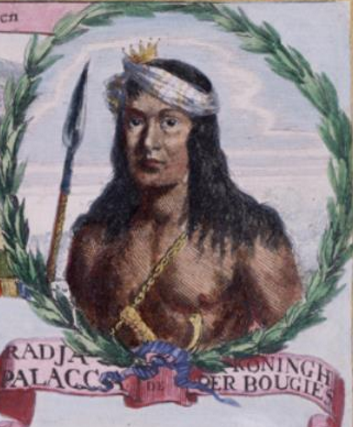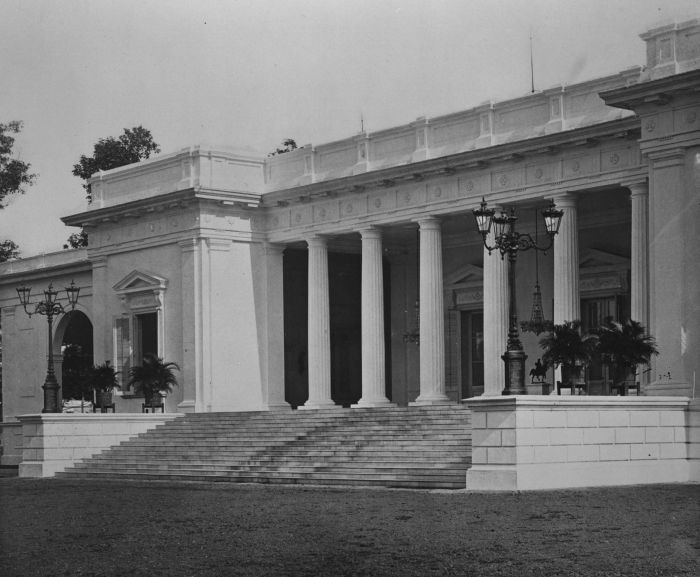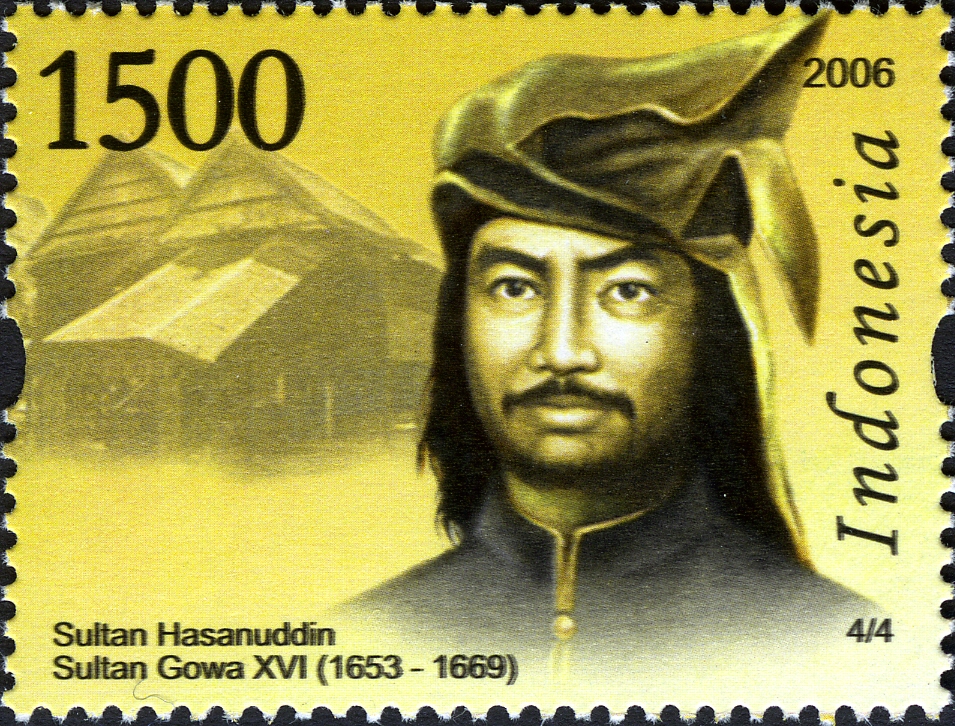|
Arung Palakka
Arung Palakka, or La Tenritatta to Unru' (1634 or 16351696) was a 17th-century Bugis prince and warrior. He supported the Dutch East India Company (VOC) in the Makassar War (1666–1669) against the Gowa Sultanate in his native South Sulawesi (today part of Indonesia). After the defeat of Gowa, he became the King of Bone and South Sulawesi's most powerful man."Bone" ''Royal Ark'', diakses 17 Februari 2007 Biography Arung Palakka was born in 1634 or 1635 in the village of Lamatta, Mario-ri Wawo, . His father was LaPottobune Arung Tana ...[...More Info...] [...Related Items...] OR: [Wikipedia] [Google] [Baidu] |
Bone State
Bone (also ''Boni'', or ''Bone Saoraja'') was a sultanate in the south-west peninsula of what is now Sulawesi (formerly Celebes), a province of modern-day Indonesia. It came under Dutch rule in 1905, and was succeeded by the Bone Regency. Covering an area of , Bone's chief town Boni, lay northeast of the city of Makassar, home to the Bugis people. History Bone was an '' adat''-based Bugis kingdom whose origins can be traced back to the early 15th century. Its chronicle (as yet unpublished) provides detailed information on its rulers, starting from La Umasa, who ruled in the early 15th century, through to La Tenrtatta, who died in 1699. Under La Umasa and his nephew La Saliu (Kerrépelua) who succeeded him, Bone expanded from a handful of settlements around the modern capital Watampone to a small kingdom roughly one-third the size of kabupaten Bone. In the early 16th century the kingdom expanded northwards, fighting with Luwu for control of the mouth of the River Cen ... [...More Info...] [...Related Items...] OR: [Wikipedia] [Google] [Baidu] |
Bugis People
The Bugis people (pronounced ), also known as Buginese, are an ethnicity—the most numerous of the three major linguistic and ethnic groups of South Sulawesi (the others being Makassar and Toraja), in the south-western province of Sulawesi, third-largest island of Indonesia. The Bugis in 1605 converted to Islam from Animism. The main religion embraced by the Bugis is Islam, with a small minority adhering to Christianity or a pre-Islamic indigenous belief called ''Tolotang''. Despite the population numbering only around six million, the Bugis are influential in the politics in modern Indonesia, and historically influential on the Malay peninsula, Sumatra, Borneo, Lesser Sunda Islands and other parts of the archipelago where they have migrated, starting in the late seventeenth century. The third president of Indonesia, B. J. Habibie, and a former vice president of Indonesia, Jusuf Kalla, are Bugis. In Malaysia, the former prime minister Muhyiddin Yassin has Bugis ancestry. ... [...More Info...] [...Related Items...] OR: [Wikipedia] [Google] [Baidu] |
1696 Deaths
Events January–March * January 21 – The Recoinage Act, passed by the Parliament of England to pull counterfeit silver coins out of circulation, becomes law.James E. Thorold Rogers, ''The First Nine Years of the Bank of England'' (Clarendon Press, 1887 p. 41 * January 27 – In England, the ship HMS ''Royal Sovereign'' (formerly ''HMS Sovereign of the Seas'', 1638) catches fire and burns at Chatham, after 57 years of service. * January 31 – In the Netherlands, undertakers revolt after funeral reforms in Amsterdam. * January – Colley Cibber's play ''Love's Last Shift'' is first performed in London. * February 8 (January 29 old style) – Peter the Great who had jointly reigned since 1682 with his mentally-ill older half-brother, Tsar Ivan V, becomes the sole Tsar of Russia when Ivan dies at the age of 29. * February 15 – A plot to ambush and assassinate King William III of England in order to restore King James and the House of Stuar ... [...More Info...] [...Related Items...] OR: [Wikipedia] [Google] [Baidu] |
1634 Births
Events January–March * January 12– After suspecting that he will be dismissed, Albrecht von Wallenstein, supreme commander of the Holy Roman Empire's Army, demands that his colonels sign a declaration of personal loyalty. * January 14– France's ''Compagnie normande'' obtains a one-year monopoly on trade with the African kingdoms in Guinea. * January 19– Charles IV, Duke of Lorraine abdicates in favor of his brother Nicholas II, who is only able to hold the throne for 75 days. * January 24– Ferdinand II, Holy Roman Emperor, signs a classified order dismissing Albrecht von Wallenstein, the supreme commander of the Imperial Army. * February 18– Emperor Ferdinand II's dismissal of Commander Wallenstein for high treason, and the order for his capture, dead or alive, is made public. * February 25– Rebel Scots and Irish soldiers assassinate Bohemian military leader Albrecht von Wallenstein at Cheb. * March 1 – The Russians ... [...More Info...] [...Related Items...] OR: [Wikipedia] [Google] [Baidu] |
Trunajaya Rebellion
The Trunajaya rebellion (also spelled Trunojoyo; id, Pemberontakan Trunajaya) or Trunajaya War was the ultimately unsuccessful rebellion waged by the Madurese prince Trunajaya and fighters from Makassar against the Mataram Sultanate and its Dutch East India Company (VOC) supporters in Java (in modern-day Indonesia) during the 1670s. The rebellion was initially successful: the rebels defeated the royal army at Gegodog (1676), captured most of the Javanese north coast, and took the Mataram capital Plered (1677). King Amangkurat I died during the retreat of the royal court. His son and successor, Amangkurat II, requested help from the VOC in exchange for financial remuneration and geopolitical concessions. The VOC's subsequent involvement turned the tide of the war. VOC and Mataram forces expelled Trunajaya from Surabaya, recovered lost territories and overran his new capital at Kediri (1678). However, the rebellion continued until the capture of Trunajaya at the end of 167 ... [...More Info...] [...Related Items...] OR: [Wikipedia] [Google] [Baidu] |
Trunajaya
Trunajaya (Madurese) or Tronajâyâ, also known as Panembahan Maduretno (1649 – 2 January 1680), was a prince and warlord from Arosbaya, Bangkalan, Madura, known for leading the Trunajaya rebellion (1674–1681) against the rulers of the Mataram Sultanate on the island of Java. Rebellion Trunajaya was born in Madura. In 1674 he led a revolt against Amangkurat I and Amangkurat II of Mataram. He was supported by itinerant fighters from Makassar led by Karaeng Galesong. The Trunajaya rebellion moved swiftly and gained momentum, and captured the Mataram court at Plered in mid-1677. The Mataram king, Amangkurat I, escaped to the north coast with his eldest son, the future king Amangkurat II, leaving his younger son ''Pangeran'' (Prince) Puger in Mataram. Apparently more interested in profit and revenge than in running a struggling empire, the rebel Trunajaya looted the court and withdrew to his stronghold in Kediri, East Java, leaving Prince Puger in control of a weak court. ... [...More Info...] [...Related Items...] OR: [Wikipedia] [Google] [Baidu] |
Governor-General Of The Dutch East Indies
The governor-general of the Dutch East Indies ( nl, gouverneur-generaal van Nederlands Indië) represented Dutch rule in the Dutch East Indies between 1610 and Dutch recognition of the independence of Indonesia in 1949. Occupied by Japanese forces between 1942 and 1945, followed by the Indonesian National Revolution until 1949. Indonesia proclaimed its independence on 17 August 1945. History The first governors-general were appointed by the Dutch East India Company (VOC). After the VOC was formally dissolved in 1800, the territorial possessions of the VOC were nationalised under the Dutch government as the Dutch East Indies, a colony of the Netherlands. Governors-general were now appointed by either the Dutch monarch or the Dutch government. During the Dutch East Indies era most governors-general were expatriate Dutchmen, while during the earlier VOC era most governors-general became settlers who stayed and died in the East Indies. Under the period of British control (1811 ... [...More Info...] [...Related Items...] OR: [Wikipedia] [Google] [Baidu] |
Cornelis Speelman
Cornelis Janszoon Speelman (2 March 1628 – 11 January 1684) was Governor-General of the Dutch East Indies from 1681 to 1684. Cornelis Janszoon Speelman was the son of a Rotterdam merchant. He was born on 2 March 1628. In his 16th year, he left aboard the ''Hillegersberg'' for the Indies. He was employed as an assistant (') in the service of the Dutch East India Company (VOC). Biography In 1645 he arrived in Batavia, Dutch East Indies. He became bookkeeper (''boekhouder'') in 1648 and underbuyer (''onderkoopman'') in 1649. He became secretary (''secretaris'') to the Dutch Council of the Indies (''Raad van Indië''). He travelled with ambassador Joan Cunaeus to Persia that year, and wrote an account of the voyage. They were received by the Shah Abbas II with great festivity. Even before his voyage came to an end, in 1652 he was promoted to buyer (''koopman''). On his return to Batavia, he took up a post in the office of the bookkeeper-general (''boekhouder-generaal''), for w ... [...More Info...] [...Related Items...] OR: [Wikipedia] [Google] [Baidu] |
Sultan Hasanuddin
Sultan Hasanuddin (Sultan Hasanuddin Tumenanga Ri Balla Pangkana; (12 January 1631 – 12 June 1670) was the 16th Ruler of The Sultanate of Gowa as Sombaya Ri Gowa XVI from 1653 to 1669. He was proclaimed as Indonesian National Hero on 6 November 1973.PERANGINANGIN, Marlon dkk; ''Buku Pintar Pahlawan Nasional''. Batam: Scientific Press, 2007. The Dutch called Sultan Hasanuddin "the Rooster of the East" as he was described as aggressive in battle. Early life Sultan Hasanuddin was born in Makassar, Gowa Kingdom (on what is now part of South Sulawesi) under the name ''I Mallombasi Daeng Mattawang Muhammad Baqir Karaengta Bonto Mangape Sultan Hasanuddin'', as the name of the giving of Qadi Islam Sultanate of Gowa namely Sayyid Syaikh Jalaludin bin Muhammad (Ahmad) Bafaqih Al-Aidid, a mursyid of Baharunnur Baalwy in South Sulawesi as well as teacher tarekat of Sheikh Yusuf and Sultan Hasanuddin. He was the second prince of the 15th King of Gowa, Sultan Malikussaid who died on No ... [...More Info...] [...Related Items...] OR: [Wikipedia] [Google] [Baidu] |
Batavia, Dutch East Indies
Batavia was the capital of the Dutch East Indies. The area corresponds to present-day Jakarta, Indonesia. Batavia can refer to the city proper or its suburbs and hinterland, the Ommelanden, which included the much-larger area of the Residency of Batavia in the present-day Indonesian provinces of Jakarta, Banten and West Java. The founding of Batavia by the Dutch in 1619, on the site of the ruins of Jayakarta, led to the establishment of a Dutch colony; Batavia became the center of the Dutch East India Company's trading network in Asia. Monopolies on local produce were augmented by non-indigenous cash crops. To safeguard their commercial interests, the company and the colonial administration absorbed surrounding territory. Batavia is on the north coast of Java, in a sheltered bay, on a land of marshland and hills crisscrossed with canals. The city had two centers: Oud Batavia (the oldest part of the city) and the relatively-newer city, on higher ground to the south. It was ... [...More Info...] [...Related Items...] OR: [Wikipedia] [Google] [Baidu] |







